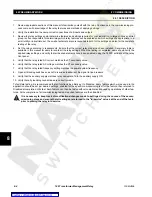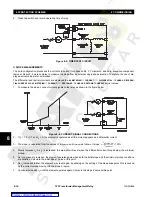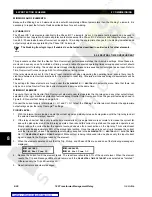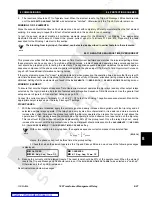
GE Multilin
745 Transformer Management Relay
8-15
8 COMMISSIONING
8.5 PROTECTION SCHEMES
8
g) SLOPE KNEEPOINT
1.
To measure the approximate kneepoint location, follow the procedure above, setting
I
1
equal to the kneepoint. Gradu-
ally increase
I
2
until the element resets. Calculate the first slope at this point. This value should be equal to the initial
slope setting. Increase
I
2
until the element operates again. Calculate the slope at this point – it should be equal to the
final slope. If the kneepoint is much different than the selected value of
I
1
, the two values of slope will be the same.
2.
For an accurate measurement of the kneepoint, select a value of
I
1
just above the kneepoint value.
3.
Increase
I
2
until the element resets. Calculate the slope – the value should be equal to the initial slope value.
4.
Increase
I
1
by a small amount, say 10%, and adjust
I
2
until a new operating point is obtained. Calculate the slope.
Repeat until the slope value equals the final slope. The kneepoint value is the value of the restraint current at which the
slope changed in value.
Keep in mind the effects of auto-configuration on the magnitude of the current signal fed to the differential ele-
ments when conducting the slope kneepoint test.
h) 2ND HARMONIC RESTRAINT
To measure the percentage of second harmonic required to block the operation of the harmonic-restraint differential ele-
ments, use the connection diagram shown below. Current is supplied as an operating current to the Phase A element.
Figure 8–7: 2ND HARMONIC RESTRAINT TESTING
1.
Close switch S1. Set the AC current,
I
AC
to 2
×
rated CT secondary. Set
I
DC
to obtain harmonic content above the 2nd
harmonic restraint setting under
S4 ELEMENTS
ÖØ
DIFFERENTIAL
ÖØ
HARMONIC INHIBIT
ÖØ
HARMONIC INHIBIT LEVEL
.
2.
Calculate the percent second harmonic content from the following equations. If the current is measured with average-
responding/reading meters:
(EQ 8.11)
If the current is measured with RMS-responding/reading meters, then:
(EQ 8.12)
3.
Open and reclose S1. The relay should not operate.
4.
Decrease
I
DC
until the element operates. Calculate the percent of second harmonic at this point using the equations
above. The calculated percent harmonic value should equal the relay setting.
i) 5TH HARMONIC RESTRAINT
Verifying the operation of the 5th harmonic restraint requires test equipment capable of generating a current signal contain-
ing a fundamental and 5th harmonic. Most modern dedicated relay test instruments, such as Powertec's (or Manta) DFR,
Doble, or MultiAmp instruments are capable of generating appropriate signals. A power operational amplifier with a suitably
rated output, or a power audio amplifier, may also be used to generate the appropriate signal.
1.
Connect the test setup as below to supply the Phase A element. Set the fundamental current level to the CT rated sec-
ondary value. The harmonic restraint differential element of Phase A should be operated.
NOTE
%2nd
100 0.424
I
DC
×
×
I
DC
0.9
I
AC
×
+
----------------------------------------------
=
%2nd
100 0.424
I
DC
×
×
I
DC
1.414
I
AC
×
+
----------------------------------------------
=
















































